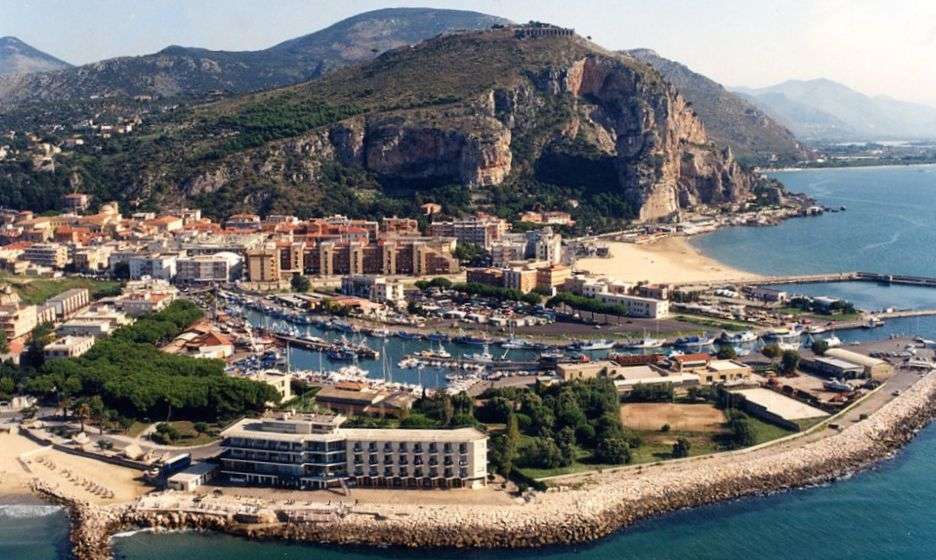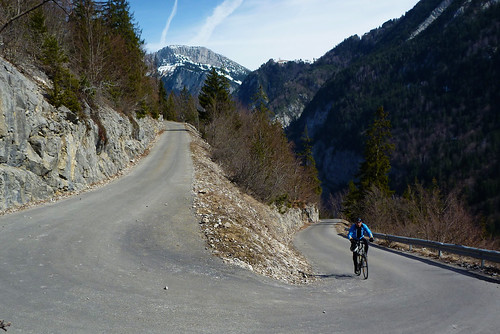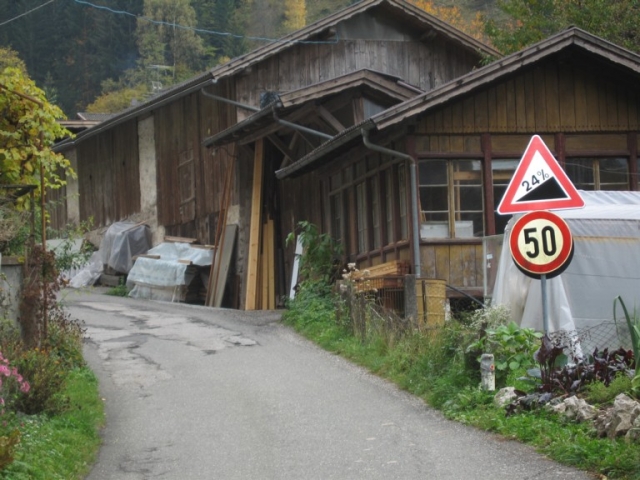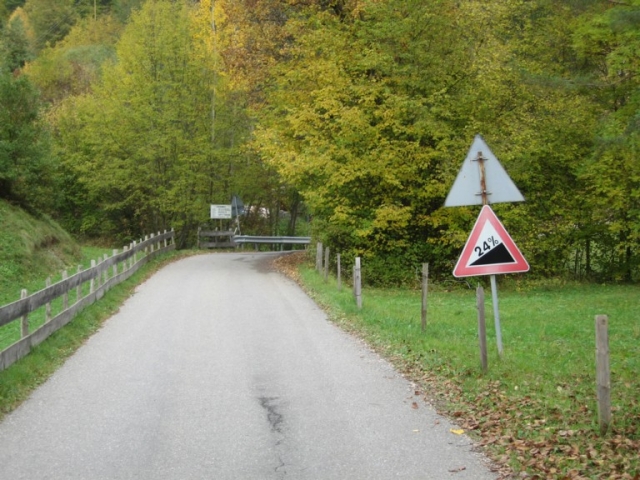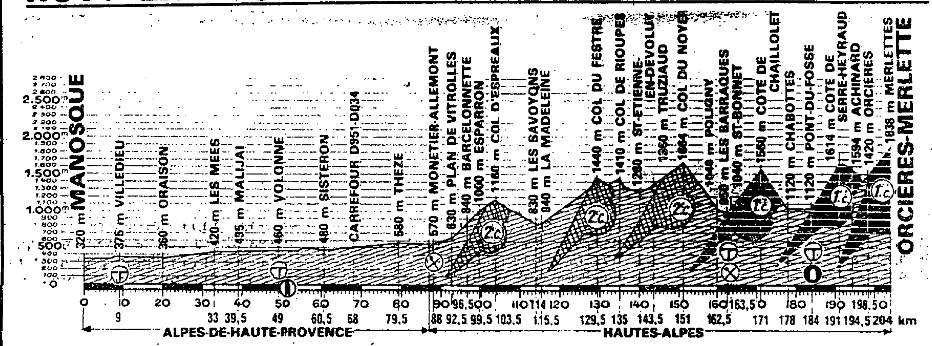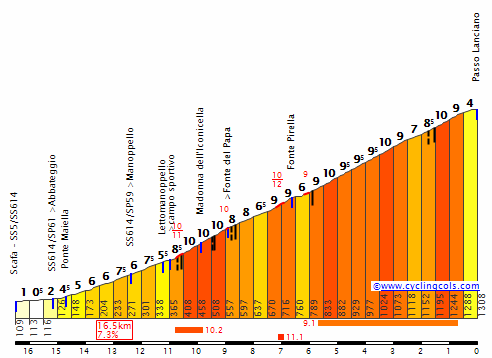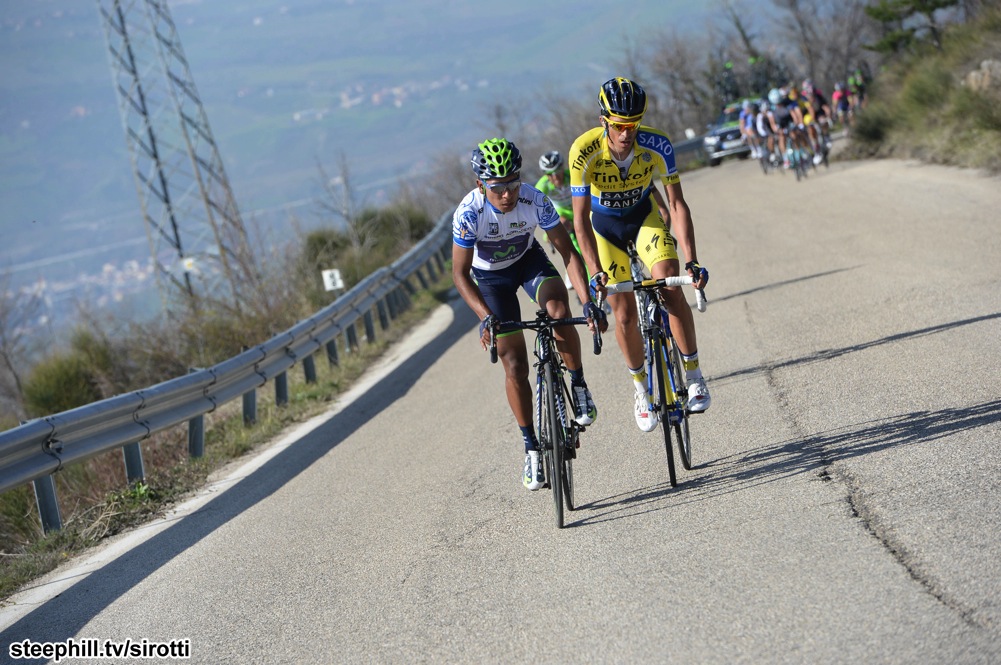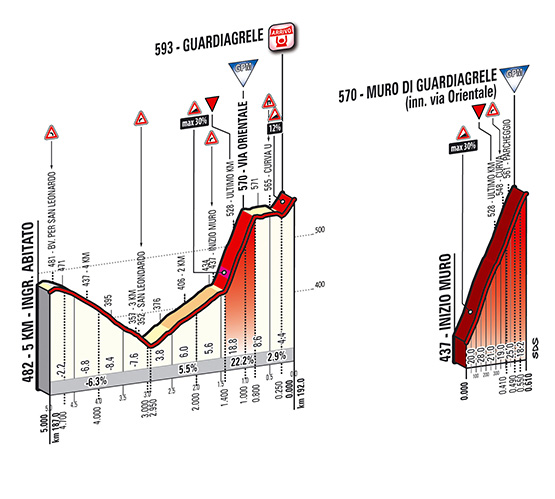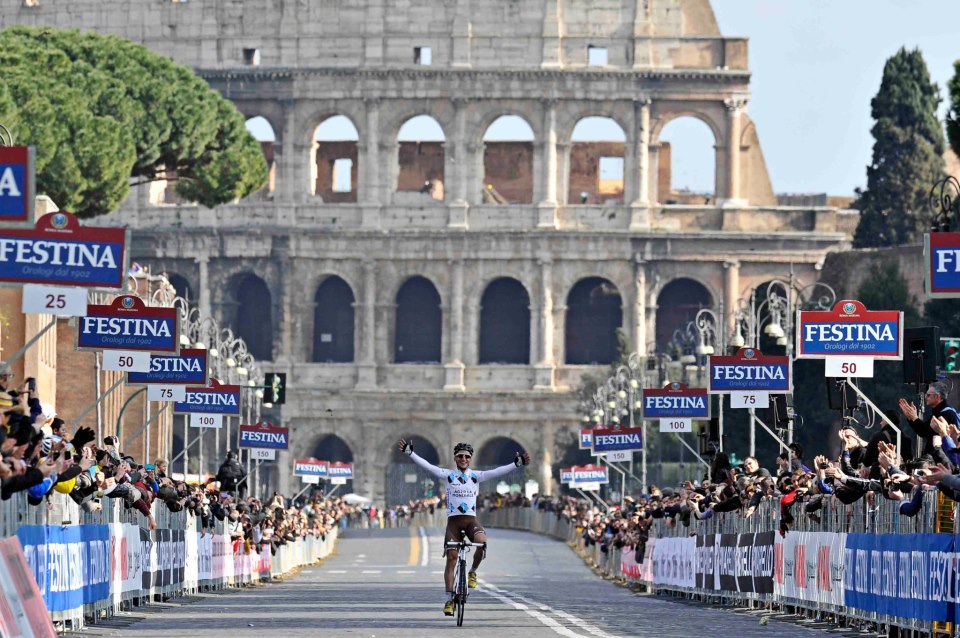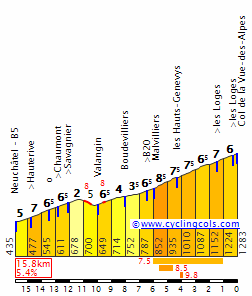Stage 17: Gex - La Chaux-de-Fonds, 189km
GPM:
Côte de Saint-Georges (cat.2) 12,3km @ 4,0%
Côte de La Praz (cat.3) 5,2km @ 5,3%
Côte de Mauborget (cat.1) 10,5km @ 6,8%
Côte de Chaumont (cat.1) 9,9km @ 7,4%
La Vue-des-Alpes (cat.1) 10,1km @ 6,3%
Yes, that's right: only one Pyrenean mountain stage in my Tour, and only two Alpine stages, with no mountaintop finishes either. The toughest of mountain stages are over, but that's not to say there aren't opportunities for the climbers to come, they just need to work harder to take advantage of them as we've moved away from the Alps and into the Jura for a stage which takes place almost entirely on Swiss territory. In fact, we cross the border after just seven kilometres of racing, and never re-enter France on the day. This might seem odd, but we do see stages like this in the GTs, if not frequently then at least far from unprecedentedly. Take
the 1992 Vuelta stage to Luz Ardiden which crossed to France over the first climb of the day and stayed there, or the
2009 Verbier stage which crossed almost immediately into Switzerland and stayed there. Perhaps the most extreme example is the forthcoming
2016 Vuelta stage to the Col d'Aubisque, which starts in a border town and crosses into France just 1km into the stage never to return; likewise the 2015 Vuelta a Castilla y León had a stage that was entirely in Portugal save for the final 900m. This will enable me to use some nice medium mountain and upper-medium mountain terrain known from the Tour de Romandie, which is far from my favourite World Tour race but does give some nice opportunities for the Tour to utilize some of its terrain without going the predictable route of producing a monster Valais stage or finishing at the rather tame Verbier. This was one of the toughest stages for me to decide on as a variety of options had been tried out based on the flow of stages, including a Mont-Noir MTF in a stage that was mostly in Switzerland but finished in France, a stage finishing after Le Chasseral, a stage to Pontarlier via Mauborget and Col de l'Aigüillon but with a tame final 30km, but eventually I settled on this.
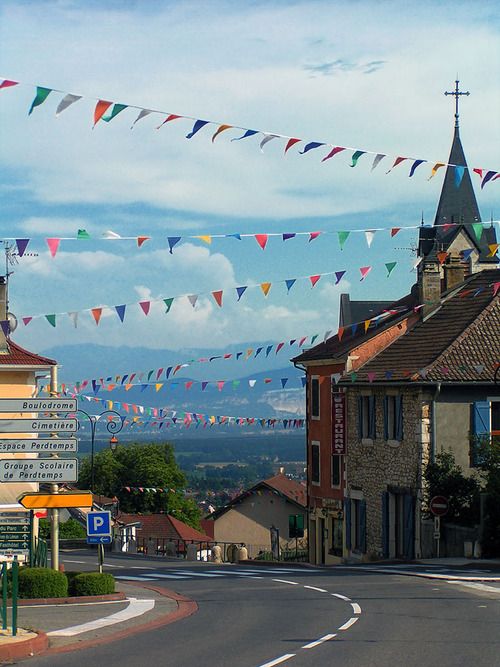
The town of Gex has around 11.000 inhabitants and sits to the north of Geneva, close to the Swiss border in the Ain département. It is the main town of the
Pays de Gex historic region, and has an enduring cycling connection as it sits at the southern edge of the Col de la Faucille, a historic climb - one of the most used in the Jura - which has been used more than 40 times in the Tour de France and still fulfils a role as one of the key climbs of the Tour de l'Ain. It was especially commonly-used in the interwar period, but was last seen in 2004 as a mid-stage climb in a week 3 transitional stage. We're not using the climb today, however, which is a rarity among Tour visits to Gex, although in fairness this would be its first time as a legit stage town.
Instead, we head across the border into Switzerland and ride along the lower edge of the Jura Vaudois, through Nyon before taking on our first climb of the day, the relatively long but uncomplicated Côte de Saint-Georges, which amounts to roughly the same as
the first 15km of the southern side of the Col de Marchairuz. As you can see, a few kilometres at 5 or 6%, but nothing here is going to really cause difficulty and it's more about allowing a break of decent strength to go as I suspect this stage may be one that is best suited to the break as, though there's likely to be at least a bit of action behind, with no time bonuses and with tough stages preceding and succeeding it the first part of the stage may well be soft-pedalled by the maillot jaune's team. Then again, I thought that about Fuente Dé, so we'll see. The péloton will ride along the shoulder of Mont Tendre for a while before taking on a third category climb to the Côte de La Praz, a stop-off on the way to the better-known Col de Mollendruz, after which they will descend through the scenic Orbe into the more well-known Yverdon-les-Bains.

From Yverdon-les-Bains we head around the north edge of the Lac de Neuchâtel in order to take on some of the neighbouring climbs. There are a few here; the toughest is the narrow, tricky Col de l'Aigüillon, the most well-known is the Col des Étroits that was used in the 2009 Verbier stage, but the climb I've chosen is the difficult-but-not-too-difficult Côte de Mauborget, a tricky climb into a
beautiful mountain village on the way to Mont-Aubert which is very popular for hang-gliding owing to its brief plateau on an attractive rolling mountainside. We actually climb
all of this profile but I'm putting the categorization points at the junction for Sainte-Croix, at the end of the 'real' climbing.
The climb to Mauborget was in fact the decisive climb in the
queen stage of the 2009 Tour de Romandie, which you can watch
here; Roman Kreuziger, the eventual GC winner, outsprinted Rein Taaramäe from a two-up of sorts with Vlad Karpets just behind and Fredrik Kessiakoff following; behind, the rest of the elites came in at +51". This shows you the climb, although obviously it will be less decisive here as a mid-stage ascent before a rolling stretch and an uncategorized climb to Rougemonne before a long and tough descent that takes us back to the edges of Lake Neuchâtel, where we then ride along rolling terrain until we arrive in the city itself which hosts our intermediate sprint.

Neuchâtel last saw Le Tour in 1998, when Tom Steels won a sprint stage late in the race as they transitioned back toward Paris, but it has hosted its more local Tour, Romandie, three times since. In 2000 it was just a stage start, but it hosted a stage won by Vino in 2011, and the decisive ITT in 2014 which was won by Chris Froome by under a second ahead of Tony Martin, enabling the controversial Kenyan-born Briton with his spider-legs technique to overhaul Romandie specialist Simon Špilak on the final day to take the GC. Here, it will signal the end of the phony war and the beginning of the part of the stage that could prove relevant for the GC, because it's also the foot of the first of the two back-to-back climbs that end the stage, the Côte de Chaumont. With
3km @ 10% right in the middle this climb, which crests just inside 30km from the line, is a surprisingly little-heralded one, but trust me, it's tough. At just under 10km at 7,5% with some inconsistent ramps, this could surprise a few as it looks less threatening than it is, but it has some nice features, such as
this waterfall and an observation tower that offers some spectacular views.
The descent of Chaumont's northern side is stupendously fast too; Andy Schleck would definitely have a complaint to make about it, as there are a couple of kilometres at no less than 12% - however these are almost ramrod straight with no technical challenges, so he can do one; the part of the descent with the twists and turns is much less fast and steep and on wider roads than at the top, so it shouldn't cause major difficulties.
And then, directly off the back of the descent, we have the final climb of the day. I don't really know why, but I really like the climb of La Vue-des-Alpes. It's not an especially difficult climb, around 10km at just over 6%, it's not at particularly high altitude, and it is fairly wide and doesn't provide a stiff technical challenge from the descent. It's lopsided with its southeastern face being much tougher than its northwestern counterpart, and although I've given it cat.1 status owing to its key position in the stage, in the Tour de Romandie the last time it was used it was only cat.2, in the
2015 Saint-Imier stage where the group was trimmed to under 50 but we still saw a reduced sprint which was unfortunately
won by Michael Albasini, a rider known for his tolerance and civil rights activism
(citation needed). I think a lot of the reason that I like it is the panorama; it has one of the best views from the summit of any climb, as looking south you can see over Chaumont to Lac Neuchâtel with the Alps rising from the Fribourgois lowlands to the south. The Tour de France has been to La Vue-des-Alpes, although it hasn't been back in nearly 40 years now. The first time was in the Lausanne-Mulhouse stage in 1948, when Gino Bartali was first over the summit, while he was wearing the maillot jaune and, because he's Gino Bartali and he's
just that awesome, preventing civil war in Italy. The following year it returned in another stupendously long stage from Lausanne to Colmar, this time with Raphaël Géminiani winning the climb en route to a long escape that took him to the line. It was last seen in 1979, from its easier northern side, in the middle of a long transitional stage between the Vosges and the Alps; since then, the Tour has rather forgotten about the climb.
(We're only doing the last 10,3km from Valangin, due to the inclusion of Chaumont)
The summit at La Vue-des-Alpes is
wide and scenic and originally I thought about an MTF here, but instead I preferred a descent, not into Saint-Imier like in Romandie 2015, but a shorter descent into the historic city of La Chaux-de-Fonds. I have got tougher climbs preceding Vue-des-Alpes than in that Romandie stage, but also by bringing the stage finish closer to the summit it should give less opportunity for things to come back together. I do definitely think that unless some riders take some crazy risks on Chaumont or somebody's really having a bad day recovering from the Le Grand-Bornand stage we are likely to see the top few riders finish together in this stage, but nevertheless, this should be a frantic finish - plus, if the break takes it as I imagine they might, we could well see some fireworks for the stage win as many second-tier climbers or those whose GC has been disrupted could well want to salvage the race, I'm thinking a lot like the 2013 escapades of Rui Costa or the 2015 performances by Rubén Plaza. The Alaphilippes, Albasinis and Špilaks of the world are those who may well be in the running for this stage as well as those aforementioned, as well as, if their GC bids have fallen by the wayside, the likes of Zakarin.
The descent into La Chaux-de-Fonds is
short and fairly straightforward, and the summit is just 8,4km from the line; I have a final 1200m loop around the city which includes a 200m ramp up a fairly steep but wide and totally straight road, then back down and then the final 700m is ramrod straight on a central thoroughfare. The city has been chosen as a finish owing to its historic nature; it is the most important watch-making city in Switzerland (which is saying something since the country is of course particularly famous for this purpose), and unique among Swiss cities in that it has been built on a North American-style grid system following the original city centre being destroyed by a fire in the 18th Century. Because of its dependence on a division of labour in the city's specialist industry and the way the grid system facilitated a fast transition from small specialist processes to large industrial concerns, it drew particular attention from Marx in
Das Kapital as a "Stadtfabrik". Owing to its historic significance the city was awarded UNESCO World Heritage Site status. The city's most famous children are the architect known by his professional name Le Corbusier, and Louis Chevrolet, founder of the eponymous automotive firm, best known in the USA and now part of General Motors.
La Chaux-de-Fonds does have plenty of cycling history too, though. It hosted the Tour in 1998 as the start of the stage which followed the one to Neuchâtel mentioned above; the stage was the same one mentioned during stage 13 in fact - won by Magnus Bäckstedt from the break in Autun. Since then it has hosted its home race several times; Romandie passes through here regularly. Most recently, in fact, just a couple of months ago, as the 2016 edition began with
a prologue through the town which was won by Ion Izagirre (depending on Movistar's GC ambitions, he may also be a contender for this stage actually). It last hosted a road stage in 2012, which was
hilly but led to the almost absurd sight of Bradley Wiggins, in the midst of his T-1000 unbeatable phase, winning the stage in a sprint. No, really.
This actually happened. If a GC man wins here today, however, it will likely be from a select group as mentioned before. This one isn't going to be easy but it simultaneously isn't a high mountain stage; it's more a transitional one, so it could be very open, however there are plenty of opportunities for riders whose form is not where it should be to lose out if fatigue is getting to them. The bookending of the race with mountain stages to prevent the usual "week 3 peak!" situation à la Ugrumov 1994 may start to play havoc with riders' form curves at this point, so this could be more intriguing than it looks, and if it isn't it should still be moderately selective, have an effect in the days to come, and produce a good fight from the break.


